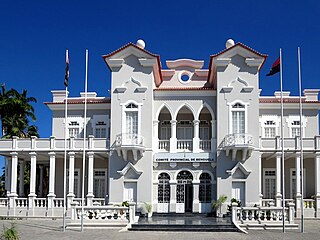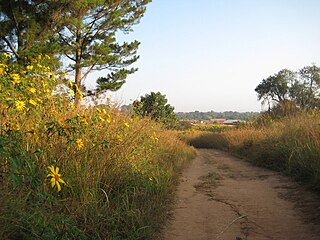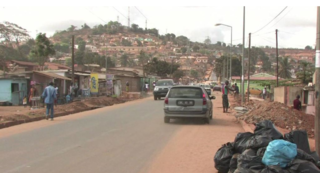
Zambia, officially the Republic of Zambia, is a landlocked country at the crossroads of Central, Southern and East Africa. It is typically referred to being in South-Central Africa or Southern Africa. It is bordered to the north by Democratic Republic of the Congo, Tanzania to the north-east, Malawi to the east, Mozambique to the southeast, Zimbabwe and Botswana to the south, Namibia to the southwest, and Angola to the west. The capital city of Zambia is Lusaka, located in the south-central part of Zambia. The population is concentrated mainly around Lusaka in the south and the Copperbelt Province to the north, the core economic hubs of the country.

After independence in 1964 the foreign relations of Zambia were mostly focused on supporting liberation movements in other countries in Southern Africa, such as the African National Congress and SWAPO. During the Cold War Zambia was a member of the Non-Aligned Movement.

The Zambezi is the fourth-longest river in Africa, the longest east-flowing river in Africa and the largest flowing into the Indian Ocean from Africa. Its drainage basin covers 1,390,000 km2 (540,000 sq mi), slightly less than half of the Nile's. The 2,574-kilometre-long (1,599 mi) river rises in Zambia and flows through eastern Angola, along the north-eastern border of Namibia and the northern border of Botswana, then along the border between Zambia and Zimbabwe to Mozambique, where it crosses the country to empty into the Indian Ocean.

Moxico or Moshiko is the largest province of Angola. It has an area of 223,023 square kilometres (86,110 sq mi), and covers 18% of the landmass of Angola. The province has a population of 758,568 and a population density of approximately 3.4 residents per km², making it one of the most sparsely populated areas of Angola. The population of the province is in flux; displaced residents have slowly returned to Moxico since the end of the Angolan Civil War in 2002. The war left Moxico as one of the most landmine-contaminated places in the world. The governor of the province is Gonçalves Manuel Muandumba.

Benguela is a city in western Angola, capital of Benguela Province. Benguela is one of Angola's most populous cities with a population of 555,124 in the city and 561,775 in the municipality, at the 2014 census.

The Benguela Railway is a Cape gauge railway line that runs through Angola from west to east, being the largest and most important railway line in the country. It also connects to Tenke in the Democratic Republic of the Congo (DRC), and to the Cape to Cairo Railway.

Mwinilunga is a town in the North-Western Province of Zambia. It is the headquarters of Mwinilunga District, one of the province's eleven districts.

Cabinda, also known as Chioua, is a city and a municipality located in the Cabinda Province, an exclave of Angola. Angolan sovereignty over Cabinda is disputed by the secessionist Republic of Cabinda. The city of Cabinda had a population of 550,000 and the municipality a population of 624,646, at the 2014 Census. The residents of the city are known as Cabindas or Fiotes. Cabinda, due to its proximity to rich oil reserves, serves as one of Angola's main oil ports.
The Municipality of Bundas lies at the south-eastern corner of Moxico Province of Angola near the border with Zambia. Its principal town is Lumbala. Due to the destruction of the Angolan Civil War, it is one of the most remote municipalities in Angola and access remains a large problem despite significant progress, as many roads are still not cleared of land mines and many bridges remain destroyed, but easily accessed by a tar road from Luena and a gravel road from the Zambian border to N'inda and a tar road to Lumbala N'guimbo.

The 2010 Africa Cup of Nations, also known as the Orange Africa Cup of Nations for sponsorship reasons, was the 27th Africa Cup of Nations, the biennial football championship of Africa (CAF). It was held in Angola, where it began on 10 January 2010 and concluded on 31 January.

Bolusia is a genus of flowering plants in the family Fabaceae. It belongs to the subfamily Faboideae. It includes six species native to southern Africa.

Shangombo District with headquarters at Shangombo is located in Zambia. As of the 2010 Zambian Census, the district had a population of 84,070 people. This population is a combined figure with the newly created district of Sioma which was created by halving the primary district. The western part of the half retains the name Shangombo while the eastern part is called Sioma District.
Kavango–Zambezi Transfrontier Conservation Area is the second-largest nature and landscape conservation area in the world, spanning the international borders of five countries in Southern Africa. It includes a major part of the Upper Zambezi River and Okavango basins and Delta, the Caprivi Strip of Namibia, the southeastern part of Angola, southwestern Zambia, the northern wildlands of Botswana and western Zimbabwe. The centre of this area is at the confluence of the Zambezi and Chobe Rivers where the borders of Botswana, Namibia, Zambia and Zimbabwe meet. It incorporates a number of notable national parks and nature sites, including Chobe National Park, Hwange National Park, and the Victoria Falls. The region is home to a population of approximately 250,000 animals, including the largest population of African Elephants in the world.
Paulo Manuel Banha Torres is a Portuguese former footballer who played as a left back, currently the manager of Angolan club C.R.D. Libolo.

Visitors to Angola must obtain either a visa in advance from one of the Angolan diplomatic missions or a pre-visa online, unless they come from one of the visa exempt countries.

Aeollanthus (rocksage) is a genus in the mint family, Lamiaceae. All the species are native to Africa.

Haumaniastrum is a genus of flowering plants in the mint family, Lamiaceae, first described in 1959. The species are native to Africa.

Pycnostachys is a genus of plants in the family Lamiaceae, first described in 1826. It is native to sub-Saharan Africa including Madagascar.
- Pycnostachys abyssinicaFresen. - Ethiopia
- Pycnostachys angolensisG.Taylor - Angola
- Pycnostachys batesiiBaker - Cameroon, Zaïre, Sudan, Uganda
- Pycnostachys chevalieriBriq. - Central African Republic
- Pycnostachys ciliataBramley - Tanzania, Malawi, Mozambique, Zambia
- Pycnostachys coeruleaHook. - East Africa from Ethiopia to Botswana; Madagascar
- Pycnostachys congensisGürke - Zaïre, Zambia
- Pycnostachys de-wildemanianaRobyns & Lebrun - East Africa from Burundi to Zimbabwe
- Pycnostachys deflexifoliaBaker - Kenya, Tanzania, Uganda
- Pycnostachys descampsiiBriq. - Zaïre
- Pycnostachys elliotiiS.Moore - Zaïre, Uganda
- Pycnostachys eminiiGürke - from Cameroon to Ethiopia + Tanzania
- Pycnostachys erici-roseniiR.E.Fr - Zaïre, Uganda, Burundi, Rwanda
- Pycnostachys goetzeniiGürke - Zaïre, Uganda, Rwanda
- Pycnostachys gracilisR.D.Good - Angola
- Pycnostachys graminifoliaPerkins - Tanzania
- Pycnostachys kassneriDe Wild - Zaïre, Zambia, Tanzania
- Pycnostachys lancifoliaBramley - Tanzania
- Pycnostachys meyeriGürke - western + central Africa
- Pycnostachys nepetifoliaBaker - Kenya
- Pycnostachys niamniamensisGürke - South Sudan, Kenya, Uganda
- Pycnostachys orthodontaGürke - Zimbabwe, Mozambique, Zambia, Tanzania
- Pycnostachys parvifoliaBaker - Zambia, Tanzania, Malawi
- Pycnostachys prittwitziiPerkins - Zambia, Tanzania
- Pycnostachys pseudospeciosaBuscal. & Muschl. - Zaïre, Zambia
- Pycnostachys recurvataRyding - Ethiopia
- Pycnostachys reticulata(E.Mey.) Benth. - central + southern Africa
- Pycnostachys ruandensisDe Wild. - east-central Africa
- Pycnostachys schliebeniiMildbr. - east-central Africa
- Pycnostachys schweinfurthiiBriq - western + central Africa
- Pycnostachys speciosaGürke - Kenya, Uganda, Tanzania, Rwanda
- Pycnostachys sphaerocephalaBaker - Zambia, Tanzania, Malawi, Zaïre
- Pycnostachys stuhlmanniiGürke - central Africa
- Pycnostachys umbrosa(Vatke) Perkins - Kenya, Tanzania
- Pycnostachys urticifoliaHook. - southeastern Africa
- Pycnostachys verticillataBaker - Zambia, Tanzania















